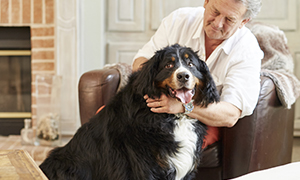Efficacy and tolerance of a high-protein high-fibre low-starch diet for weight loss in client-owned obese dogs: a randomized double-blind controlled evaluation

Introduction
Obesity is the most common nutritional condition in dogs and its prevalence has been increasing for years.1-3 The conventional strategy for
obesity management implies dietary energy restriction combined with increased activity.4 Weight loss programs are successful in
experimental conditions but not as well in practices.5,6 Besides involvement of both veterinary clinic team and pet family and a rigorous
follow-up, palatability and satiety are nutritional key points to maintain compliance and increase success rate in weight loss programs.7,8
Animals, materials and methods
Sixty client-owned overweight or obese dogs (BCS>7/9) were recruited. After a 6-day diet transition, dogs were fed exclusively 1 of the 2 commercially available dry dietetic foods, Test and Control (Table 1) during a weight loss program, in association with an individualized activity program. At the time of inclusion, the tgt BW was defined for each dog. The initial energy allowance for weight loss was 78 kcal / kg tgt BW0.67. The maximum duration of the program was fixed at 9 months (M9), and the success rate was defined as the % of dogs achieving their tgt BW at M9 at the latest. Vet evaluations were scheduled once a month until tgt BW was achieved. At the end of each consultation, the clinician could adjust the daily feeding ration and the level of physical activity depending on the results in BW loss and dog’s behavior. Blood sampling was performed when tgt BW was achieved or at M9, and a
questionnaire was filled in by owners. The criteria to measure and compare the efficacy and tolerance of the diets were from the vets’ assessments: change in BW, success rate, time to achieve tgt BW, speed of weight loss, change in blood parameters, and from the owners’ questionnaires: palatability, satiety feeling, safety and general satisfaction. Sign and Mann-Whitney (Wilcoxon) tests were used to perform intra- and inter-group comparisons, with a 5% significance level. Test diet: Virbac VeterinaryTM HPM Weight Loss & Control Dog, Control diet: Hill’sTM PRESCRIPTION DIETTM Canine Metabolic.

Results
Fifty-five dogs completed the study (27 in the Test group and 28 in the Control group): mean age 6.6±2.9 years, 65% females, 75% neutered, mean BW 28.2±14 kg, mean BCS 7.9±0.7, and mean overweight 30.2±10.4%. All dogs lost weight during the study, mean weight loss was significant as early as M1 in the 2 groups (Fig.1). Sixteen dogs in each group succeeded in the achievement of their tgt BW. In Test group, 9 (56%) dogs achieved it before M9 vs 2 (13%) dogs in Control group (Fig.2). Thus, mean time to achieve tgt BW was significantly shorter in Test group than in Control group (27 vs 34 weeks, p=0.015) with a mean speed of weight loss of 0.90±0.50 %/week in Test group vs 0.66±0.25 in Control group.
The shortest duration was found in Test group (9 vs 18 weeks in Control group), and so was the highest speed of weight loss (2.2 vs 1.2 %/week in Control group). In dogs classified as failure cases, the loss of their initial overweight was at least of 31.5% in Test group vs 6.5% in Control group, and in average 57.1±18.2% in Test group vs 50.4±22.5% in Control
group. Serum insulin and serotonin levels decreased in the 2 groups, significantly between M0 and M9 only in Test group (p=0.02 and 0.016 respectively). Regarding owners’ questionnaires, no significant differences appeared between the 2 diets. Most of dogs appreciated the diets: “good or very good” for 96% and 88% dogs in Test and Control groups respectively. Palatability even increased throughout the study for 33% dogs in Test group vs 19% in Control group. Digestive safety was high in both groups: same mean fecal score
(2.1±0.5 on a scale from 1: too dry and hard to 5: liquid, optimal 2-3), light fecal odour for 59% and 52% dogs, no flatulence in 82% and 69% dogs in Test and Control groups respectively. Coat condition was improved in 40% dogs independently of the diets. Finally, the owners’ satisfaction score was similar with the Test and Control diets: 8.9±0.9 (from 8 to 10) and 8.9±1.2 (from 5 to 10) respectively, on a scale from 0: not satisfied at all to 10: absolutely satisfied.


Conclusions
The 2 diets were well tolerated and appreciated throughout the study and demonstrated their efficacy for weight loss. Based on some criteria, especially time to achieve target body weight, the new diet was even more efficient than the reference diet.

